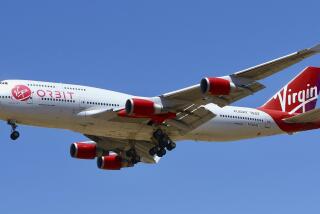MD-11 Keeps Lots of Bodies Busy : San Diego Hoping Convair Operation Survives a Possible Sale
- Share via
SAN DIEGO — The General Dynamics Convair Division plant near Lindbergh Field that employs 3,500 San Diegans has been manufacturing massive passenger jet fuselages for Long Beach-based Douglas Aircraft Co., maker of the MD-11 jetliner, for several decades.
And, according to some industry observers, there is a good chance that Convair’s MD-11 business will remain in San Diego even if it is sold during General Dynamics’ ongoing corporate restructuring.
General Dynamics has declined to comment on possible buyers for the MD-11 business. But on Wednesday, Northrop Chairman Kent Kresa said the company is in “early discussions” with General Dynamics about possibly buying the business.
Employees at Convair’s San Diego-based missiles operation, which General Dynamics earlier agreed to sell to Hughes Aircraft, may not be so lucky. That proposed deal sparked speculation that local jobs could be lost if Hughes consolidates its missiles operations at a massive but underused plant in Tucson.
While Hughes could probably consolidate the missile group in Tucson relatively easily, the MD-11 production line has stronger ties to San Diego, said Dan Pegg, president of the San Diego Economic Development Corp.
Convair is the sole producer of the massive aircraft bodies used in the MD-11, so it alone has the machine tools and dies needed to build the assemblies. And San Diego is close to Long Beach, where Douglas Aircraft, the commercial aerospace unit of McDonnell Douglas Corp., assembles the MD-11.
“The fact that we can put (fuselages) on barges and quickly run them up to Long Beach has significant value” to the eventual buyer, Pegg said.
General Dynamics executives “believe that the costs associated with relocating the (MD-11 line) would be significant,” Pegg said. “So regardless of who might buy it, there would have to be tremendous cost savings . . . before there could be any (out-of-town) consolidation.”
Northrop, which manufactures Boeing 747 jetliner fuselages at its Hawthorne plant, is positioning itself to become the nation’s leading producer of commercial fuselages and aft sections.
Earlier this month, Northrop agreed to acquire a 49% interest in Dallas-based LTV Corp.’s aircraft business, which produces major portions of three Boeing jetliners, as well as the C-17 military cargo jet and the B-2 bomber.
Convair’s 2.8-million-square-foot plant near Lindbergh Field is representative of how geographically scattered the fuselage business has grown.
While San Diego civic leaders hope Convair’s proximity to Long Beach will help keep the business in town, the commercial airline business has been changing, lessening the importance to aircraft builders of geography. Increasingly, commercial airliner fuselages are being built around the world.
At Boeing’s Commercial Airplane Group in Seattle, subcontractors now account for about half of the parts used in new aircraft rolling off production lines.
That dependence on subcontractors extends to the cylindrical fuselage sections where passengers sit and luggage is stored. “We here at Boeing are nothing but a big assembly plant, so to speak,” said Tom Cole, a Boeing spokesman.
Boeing, the world’s leading commercial aircraft manufacturer, still builds its own 737 fuselages at a company plant in Kansas. But both Boeing and Douglas are totally dependent on major subcontractors for certain commercial fuselages.
Northrop’s Hawthorne plant, for example, has manufactured fuselage sections for every Boeing 747 jetliner ever produced. Similarly, Convair holds the sole production contract for MD-11 fuselage sections. The fuselage industry also has grown internationally, with Japanese manufacturers now producing major sections of 767 fuselages.
Because of the far-flung geographical spread, parts for jetliners arrive at assembly points via trains, ships and trucks.
Ocean-going freighters carry 767 assemblies from Japan to a dock in Seattle, where they are transferred to a rail line. Northrop ships its massive 747 aircraft structures from Hawthorne to Seattle by rail.
LTV ships massive tail assemblies from Dallas to Seattle aboard specially designed rail cars, which travel along a carefully designed route that avoids low overpasses. Convair uses ocean barges and trucks to haul aircraft fuselages to Long Beach.
While Boeing and Douglas occasionally change suppliers for engines, avionics and cabin components, they have rarely changed fuselage manufacturers.
Boeing’s fuselage suppliers have remained “very stable,” Cole said. Similarly, Convair, which manufactures fuselages for Douglas’ MD-11, also made nearly 400 fuselages for the MD-11’s predecessor, the DC-10.
“You have to have a pretty special company to build fuselages,” Cole said. “We’re not going to simply do business with some company in Vermont that says it wants to make 747 fuselages.”
Fuselage manufacturers “have to have a large space . . . then you need the tools and dies,” Cole said. “We’re not making toasters, or some smaller consumer item that anyone can turn out.”
While San Diego officials worry about losing jobs if a new owner transfers the MD-11 operation out of town, Northrop’s Kresa said any consolidation of the aircraft operations of LTV, Convair and Northrop--even if the deals are completed--is “at least three years down the road.”
Other industry observers said it is too early to determine how the fuselage businesses might be consolidated if Northrop acquires the Convair and LTV units.
Northrop has excess capacity at its massive Hawthorne plant. Other aerospace companies, including Rockwell and Lockheed, have capacity at plants where production of military and commercial aircraft has slowed or stopped.
In contrast, LTV is using nearly all of a 4.9-million-square-foot government-owned facility to build missiles and aircraft, according to an LTV spokesman.
More to Read
Inside the business of entertainment
The Wide Shot brings you news, analysis and insights on everything from streaming wars to production — and what it all means for the future.
You may occasionally receive promotional content from the Los Angeles Times.










